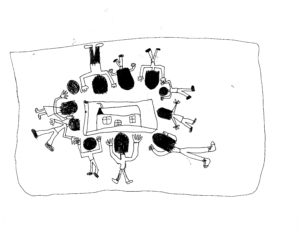Building YOUR City: A Dialogue with Third Graders about Urban Planning
A few weeks ago, I was given the opportunity to speak about land use planning with third graders at Julien Hathaway Elementary School in Oxnard, California.
I have an uncanny talent of making my husband fall asleep as soon as I mention “entitlements”, “zoning clearances” or any acronym specific to the planning world (CUP, LUP, SCD, etc.). So, I was extremely nervous about how to make Urban Planning exciting and intriguing to eight-year-old children. I felt waves of nervousness and even a bit of anxiety as I was escorted by a small child to my new “Council Chambers” (aka Room 9). I was well equipped with plans, notes, and the like, ready to try and make an hour of time entertaining to all participants, and boy was it ever!
I opened with the question – “What do you need in a City?” Hands rose up to the sky as I heard everything from “trees” to “restaurants for people to eat in”, to “water”, “grocery store”, “hospital”, and even “fields”.
“Oh yes, fields to play in and Open Space?” – I said in response.
“No – fields for the workers – so they can work on the food.” – his response.
Never a day goes by that I don’t learn a lesson from someone smaller than me.
Oxnard is a predominantly Hispanic city, with many field workers who spend their days in the agricultural fields that bound the City. Being born in Oxnard, I’ve always had an affinity for the youth and culture here. Hence, this child’s response resonated with me and has stayed with me since.
Working in Santa Barbara County has its own challenges and unique features as it relates to Urban Planning. Dealing with historic resources, environmentally sensitive habitat, and cultural resources are all elements that we work with on a daily basis. The “City basics” (in some form) are covered – hospitals, law enforcement, roads, etc. are established and well-functioning. Jobs are here, grocery stores provide food, and we even have the luxury of having organic fruits and vegetables delivered to our doorstep if we so choose.
Agricultural projects don’t come across our desks often, but it’s something we have to consider in urban planning when it comes to adequate buffers and the Right to Farm Ordinance. Yet it’s more than a siting issue when plotting a site plan on an adjacent property. These fields provide jobs, they provide food, and they provide a space for community. They are a primary feature of the community these children recognize and consider vital to their City.
After we all spoke of all the elements our Cities should contain, each child (including myself) drew their own City – complete with “edges” (ocean, mountain ranges, agricultural fields), roads, houses, markets, and even public utilities. We described looking at our Cities like birds (also known as “plan view”) – to see things from a bigger perspective and look at all the elements our City needs to have. It was obvious that many of these children hadn’t thought of looking at the world in that manner – and it seemed to ignite their creativity with all the possibilities that one can imagine looking down at their City from the sky. They were so excited to share with me each of their City’s features – calling me over to their desks to look at how they were building their City. Pointing out their favorite features, naming their Cities, and being so proud of the world they created.
And one thing is for sure – each child’s City had agricultural fields, and each City had a swimming pool. Because we always need to remember where we came from, and we need to make sure we have some fun too.
By: Maruja Clensay, Associate Planner

